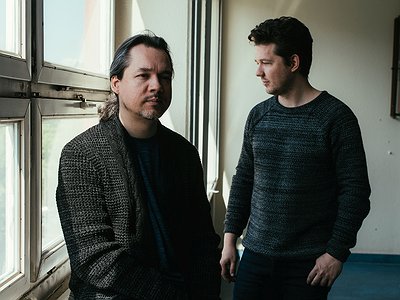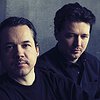Collaborations can take on many forms. What role do they play in your approach and what are your preferred ways of engaging with other creatives through, for example, file sharing, jamming or just talking about ideas?
D: As a longtime brother duo, we are very familiar with the concept and merits of collaborations – yet we are also very curious about the stories of other artists and open to their approaches.
S: That is why we founded our annual boutique festival Q3Ambientfest in Potsdam. Every year, we invite artists to play live using a pre-installed playground-like set up. They come to share their ideas and – in the best case scenario – spark collaborations.
D: The festival is dedicated to the music of contemporary artists – as well as curious like-minded listening. Three years in, this platform has become a tradition and its participants already feel very much like family.
S: We also are co-curating KOSMOSKONZERTE and created the silent movie concert series FLIMMERKONZERTE along the same lines, inviting selected guests to share the stage with us.
Could you take us through a day in your life, from a possible morning routine through to your work? Do you have a fixed schedule? How do music and other aspects of your life feed back into each other - do you separate them or instead try to make them blend seamlessly?
S: Yes, we try to bring all aspects of our lives together. I am working as a principal cello associate at Deutsches Filmorchester Babelsberg. When Daniel and I founded our Klingenthal Studio in Potsdam, the main idea was to bring our day jobs and musical work together in one place. The ideal day would be when the orchestra is starting on a new score by Max Richter,Daniel and I – still inspired by the session – can record a new musical sketch in that same evening.
D: I work at the State Music School in Potsdam and it actually was one of my students who kicked off the first edition of Q3Ambientfest in 2017.
Could you describe your creative process on the basis of a piece or album that's particularly dear to you, please? Where did the ideas come from, how were they transformed in your mind, what did you start with and how do you refine these beginnings into the finished work of art?
S: Our creative process is always changing – it is a work in progress and we rarely repeat structures in our pieces. Everything is based around our shared childhood stories growing up in the GDR. It is those memories, images, the architecture, and the music that constantly spark ideas for new tracks – simply by playing around with basic fragments.
D: It only takes fifth on G and D in a special tempo from Sebastian’s cello to get me jamming – which again gives him something to play around with. And so this goes on and on. It’s all about acting and reacting, just like in a conversation.
There are many descriptions of the ideal state of mind for being creative. What is it like for you? What supports this ideal state of mind and what are distractions? Are there strategies to enter into this state more easily?
D: Our approach is rather simple: we meet up in the studio, sit down in front of our setup and start jamming, completely forgetting about time and other tasks.
S: Right, but often this happens after all other work has been done. We split our days into different tasks. There are days solely dedicated to socialising, cutting visuals, updating the website, organizing the festival and so on. Most of the time, being in the studio means that everything else is done – it is always a reward, a present. It is with this mindset that we can continue being creative and come up with new ideas.
D: We have come to realize that we are way too distracted if we leave other business unfinished.
How is playing live and writing music in the studio connected? What do you achieve and draw from each experience personally? How do you see the relationship between improvisation and composition in this regard?
D: So far we have been sticking exactly to this; we are using the same approach in the studio as for a live show – the difference is the audience. When playing live, you are connected to the sudden reactions of individual listeners and you never know what will happen in the next few minutes. So you have to be quite alert and open at all times.
S: In the studio, you have more space to focus on yourself and the performance itself … I love performing in the studio as much as I love to talk and play with Daniel in front of an audience. I think both aspects are quite important and essential for the creative process.
How do you see the relationship between the 'sound' aspects of music and the 'composition' aspects? How do you work with sound and timbre to meet certain production ideas and in which way can certain sounds already take on compositional qualities?
S: There is a beautiful and close connection in our music between the two of us which glues together sound and composition. Listening to all these subtle textures of the bow on strings or the knocking sound of the piano hammers is more than inspiring.
That’s why some of our tracks seem kind of empty from a compositional point of view. But it is exactly these seemingly empty gaps that make us discover the music between the lines.
D: Listening to a muted cello for the first time was a very inspiring experience for me.
Our sense of hearing shares intriguing connections to other senses. From your experience, what are some of the most inspiring overlaps between different senses - and what do they tell us about the way our senses work? What happens to sound at its outermost borders?
S: Well, I think music is universally connected. I remember the final scene from the amazing Spielberg movie Encounter of the Third Kind in which humans and extraterrestrials start communicating by use of the only language both lifeforms can understand: music. They use a simple but catchy melody as well as some variations in pitch and tempo to translate their feelings to each other
D: Of course, this is just Hollywood during the 80s but for us there is a true dimension to it. As mentioned before, Sebastian and I are still closely connected to our past and our memories apply to all our senses, they are a full-body experience: we remember the scent of the fence around Funkhaus kindergarten in the 80s, we remember the look on the faces of other GDR inhabitants when we learned about the fall of the Berlin Wall in 1989, and we still feel the sand between our toes from our holidays on the island of Hiddensee.
S: And even our beautifully broken English is part of these experiences. I think we are better when talking to our musical translator – you will understand much more (laughs).
Art can be a purpose in its own right, but it can also directly feed back into everyday life, take on a social and political role and lead to more engagement. Can you describe your approach to art and being an artist?
D: Art and music can be a strong influence on everyday life and vice versa.
S: We are living in a rather complex world and sometimes things can get really complicated. But I am far from giving up. I think art – especially music in our case – is not only a means of communication but it can also give hope.
D: You can learn through art, not only by consuming it, but it can also inspire you to create art of your own: start a photo series on your phone – you will learn a lot about yourself and maybe even find an answer to a question that kept puzzling you before.
It is remarkable, in a way, that we have arrived in the 21st century with the basic concept of music still intact. Do you have a vision of music, an idea of what music could be beyond its current form?
S: History does both repeat and not repeat itself. We live in a golden age for contemporary music: you are free to find your individual language and reach out to your audience directly. If you are honest with yourself, you will even find like-minded friends. I hope it will stay this way for a long time to come. Music has always been a forward-thinking medium – and now with new technologies it is easier than ever to share it with the world. I hope that this way of thinking will also be applied to other areas of art. You don’t need high-end 3D tools to make a good movie but nowadays these are easily available to a lot of people. There are options and you have the choice to use them.
D: Sometimes that can be hard as well: you have to remind yourself to stick to the essentials.



